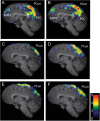The default mode network in chimpanzees (Pan troglodytes) is similar to that of humans
- PMID: 24046078
- PMCID: PMC4303805
- DOI: 10.1093/cercor/bht253
The default mode network in chimpanzees (Pan troglodytes) is similar to that of humans
Abstract
The human default mode network (DMN), comprising medial prefrontal cortex, precuneus, posterior cingulate cortex, lateral parietal cortex, and medial temporal cortex, is highly metabolically active at rest but deactivates during most focused cognitive tasks. The DMN and social cognitive networks overlap significantly in humans. We previously demonstrated that chimpanzees (Pan troglodytes) show highest resting metabolic brain activity in the cortical midline areas of the human DMN. Human DMN is defined by task-induced deactivations, not absolute resting metabolic levels; ergo, resting activity is insufficient to define a DMN in chimpanzees. Here, we assessed the chimpanzee DMN's deactivations relative to rest during cognitive tasks and the effect of social content on these areas' activity. Chimpanzees performed a match-to-sample task with conspecific behavioral stimuli of varying sociality. Using [(18)F]-FDG PET, brain activity during these tasks was compared with activity during a nonsocial task and at rest. Cortical midline areas in chimpanzees deactivated in these tasks relative to rest, suggesting a chimpanzee DMN anatomically and functionally similar to humans. Furthermore, when chimpanzees make social discriminations, these same areas (particularly precuneus) are highly active relative to nonsocial tasks, suggesting that, as in humans, the chimpanzee DMN may play a role in social cognition.
Keywords: comparative cognition; functional neuroimaging; social cognition.
© The Author 2013. Published by Oxford University Press. All rights reserved. For Permissions, please e-mail: journals.permissions@oup.com.
Figures



References
-
- Amodio DM, Frith CD. Meeting of minds: the medial frontal cortex and social cognition. Nat Rev Neurosci. 2006;7:268–277. - PubMed
-
- Buckner RL, Andrews-Hanna JR, Schacter DL. The brain's default network: anatomy, function, and relevance to disease. Ann NY Acad Sci. 2008;1124:1–38. - PubMed
-
- Buckner RL, Carroll DC. Self-projection and the brain. Trends Cogn Sci. 2007;11:49–57. - PubMed
-
- Cavanna AE, Trimble MR. The precuneus: a review of its functional anatomy and behavioral correlates. Brain. 2006;129:564–583. - PubMed
Publication types
MeSH terms
Substances
Grants and funding
LinkOut - more resources
Full Text Sources
Other Literature Sources
Molecular Biology Databases

